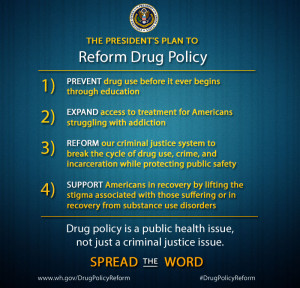
While the White House maintained a firm stance that they will not legalize drugs, they did point out that there was no way to win the war on drugs by strictly relying on the judicial system. The report listed a few startling statistics that indicate the magnitude of the drug problem in the United States and why criminal justice reform was also a necessary component.
Michael Botticelli, acting director of the Office of National Drug Control Policy (ONDCP) gave a speech where he listed out statistics from the Centers for Disease Control and Prevention (CDC). He stated that the amount of drug overdose deaths have now exceeded homicides and car accidents. Botticelli indicates that this is mostly caused by the increase in opiates such as heroin and narcotic painkillers. The drug czar went on to say that every day an average of 110 people in the United States die from a drug overdose. Of those people, half of them are related to prescription drugs.
These startling statistics paint a gloomy picture. Botticelli and President Obama made it clear that there are ways to prevent drug abuse. They stated that best way to handle a drug problem is to stop it before it even starts. This seems logical to most people, but insufficient efforts have been made thus far. Therefore, increased efforts to maximize prevention programs across the country are part of the new drug strategy. Not only is prevention the easiest way to lessen the drug problem in the United States, it is also the most cost effective on a long-term basis.
There are several indications that a person is abusing alcohol or other drugs. The ONDCP director listed several characteristics of drug abuse for the audience, but specifically he spoke to healthcare providers, saying that they need to be vigilant in recognizing substance abuse addiction. He spoke about a nurse who noticed that her patient was wearing long sleeves in the summer. Upon examination the nurse was able to identify needle marks and referred the patient to treatment.
Paying more attention to the behaviors of people around us all can help spot trouble before it gets worse and help get more people into treatment before something more tragic happens. If you have a loved one in need of a long-term rehabilitation program for a drug or alcohol problem, contact Desert Cove Recovery today.


